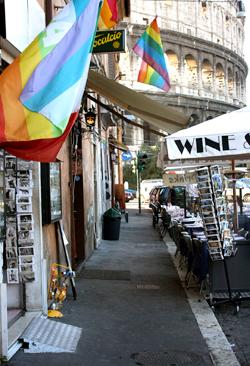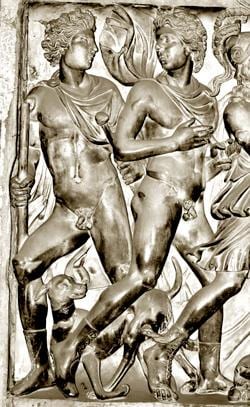
The Colosseum, with My Bar and Coming Out in the foreground. Credit: Mike Thompson

Boys cavorting at L'Alibi. Credit: Nicola Donadio

At Villa of Emperor Hadrian. Credit: Mike Thompson
Modern Rome offers incomparable food, rich art, historic sites and stylish shopping. Among the subtler pleasures, a sublime light plays across ancient marbles, setting aglow burnt sienna and ochre-coloured walls at sunset. Thousands of years of civilization are built one block upon the next, with more recent builders often using the recycled substance of a predecessor — an extraordinary complexity of landscape with odd and incongruous joints, making it a delightful city for aimless wandering. Do the postcard sights, but dare to get pleasantly lost to find those little treasures that delight the casual explorer.
The Eternal City, with its ancient legacies of language, law, architecture, religion and philosophy, still captivates the world. For anyone who grew up loving pizza, pasta, good coffee and La Dolce Vita, the place seems already familiar on arrival.
Amidst vast ruins in the olive groves at Villa Adriana, it’s hard today to imagine that Emperor Hadrian once administered the Roman Empire from this peaceful retreat, 30 kilometres from the capital. This most powerful man of his day travelled constantly throughout his domain and built much (including the eponymous British wall and the Pantheon). Lover to Antinous, whose storied beauty is seen in many statues, he wasn’t the only emperor who didn’t closet his same-sex desires.
Roman men and women can be surprisingly friendly and touchingly helpful. Sensual and passionate, sometimes raunchy and brash, Italian men are known for their style and self-confidence but abound in contradictions. With the Church still influential they can seem at once conservative and liberated. Sex among men was once considered a harmless fact of life of no great significance — not spoken of, but certainly not a matter of identity.
Gay styles have changed, but things are still more traditional and Mediterranean than in European cities to the north. Without doubt, however, gay men and lesbians are now much freer to live together, and gay club kids, bears, drag divas, lesbians and leathermen look to Paris and Berlin to create their own social spaces. Masculine displays of affection among friends and family are often effusive and public, and welcomes bestowed on visitors can be enthusiastic and generous.
An archaeological and artistic wonder, Rome is also a Christian spiritual destination, centred at St Peter’s Basilica. What remains of pre-Christian Rome is a window into older concepts of sexuality — the ancients didn’t equate nudity with sin, and sex for pleasure was more disconnected from social and family obligations. This alternative aesthetic had a complex and conflicted relationship with the Church, but the Vatican Museum, paradoxically, is now home to one of the world’s most amazing collections of nude male beauty.
During the remarkable 15th century, the finest artists of their time were employed by patrons such as the Medici family of Florence, which also contributed four popes. As the West emerged from the “dark ages” it looked to the old empire as a cultural beacon.
The Vatican complex includes the Museo Pio-Clementino, with 54 galleries, and Michelangelo’s Sistine Chapel masterpiece. Postures and knowing looks, faithfully captured by the master artist, betray his affection for the urchins who portrayed angels and saints, intact with the grit and grime they brought with them as models. They transcend their humble origins to bridge the millennia, recalling an older world we can no longer fully comprehend.
Spare time for other halls, including Museo Chiaramonti, Museo Gregoriano Etrusco and Museo Egiziano, with ancient Roman, Greek, Etruscan and Egyptian materials. The Vatican Museum’s website (mv.vatican.va), offers extensive virtual tours.
The Borghese Gallery (galleriaborghese.it) has works by Caravaggio, Bernini, Canova, Rubens, Raphael, Titian and others from the Cardinal Scipione collection; the Capitoline Museums (en.museicapitolini.org) collection ranges over ancient art and architecture.
The Villa of Hadrian, the emperor’s retreat to the east of the city, in Tivoli, includes the greatest Roman example of an Alexandrian garden.
English, widely used on public signs, is understood by many, especially in gay circles. The cost of taking care of basic needs can be quite affordable outside the tourist traps. The 2nd Floor, near the Colosseum, has the most gay-friendly lodgings, and the mixed Ares Rooms is one of a cluster of reasonably priced hotels in the area between Termini Station and Via Nazionale. Book ahead, especially in summer, when demand exceeds supply.
Public transport, 1 euro for 75 minutes of bus travel or one metro ride, is a good way to get around town. Multi-trip, multiday passes lower the price further. “Nocturnal” buses run regularly all night, and taxis can fill the gaps. The adventurous and agile may rent motorbikes.
Rome’s gay scene is scattered all over the city, but most venues are within walking distance of the Colosseum or Termini Station. Termini has long been a cruising area, too: inside, outside and in the restrooms. But beware of pickpockets and those who might distract you as a silent partner disappears with your bag.
Just south of the Colosseum, Via di San Giovanni in Laterano has been designated Gay Street since 2007.
Several gay and lesbian favourites: Coming Out and My Bar, near the Colosseum, for both men and women; and Hangar bar, for men, near Cavour Station, where English-speaking owners John and Gianni are always at the door. Muccassassina, on Fridays, and Alibi, on Saturdays, are two big dance nights, with afterhours dancing at Frutta e Verdura. The Eagle, K-Club, Il Diavolo Dentro, Gate/Frequency and Skyline are men’s cruise and sex clubs. Some clubs close in summertime as people quit the city, but for several years Gay Village has put on concerts, shows, theatre, films and dance extravaganzas. EMC is the largest of three downtown gay saunas.
Many gay bars and saunas require membership in Arcigay, the national gay organization. A card bought at one club is valid nationwide, and the fee helps gay Italians create a more equitable society. Arcigay’s website lists members, along with other information.
Settimo Cielo (Seventh Heaven) is a popular gay beach off Via Litoranea, beside a pine forest on the Roman coast at Ostia. A mixed crowd gathers here for loud music and beach volleyball games or to relax, using umbrellas and chaises longues, which can be rented. Admission is free (unlike many private Italian beaches), and a summertime catering service offers a rich buffet of rice, fruit or pasta salads, sides, and cool drinks throughout lazy afternoons. A quiet area may be reserved where nobody will disturb you.
For map locations and website links to more than 100 area places of interest see our gay Rome listings pages.

 Why you can trust Xtra
Why you can trust Xtra